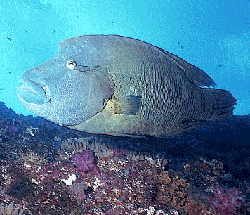|
|
Staff involved:Nick Dulvy, Nicholas Polunin, John Reynolds and othersFunding:NERC
Such large, slow growing, late maturing fishes tend to have little capacity to replace those killed by fishers |
Detecting fish extinctionsProjectTerrestrial ecologists can track the decline and disappearance of individual birds and mammals with relative ease. However, in the sea it is harder to find and count animals. Consequently scientists may be unable to detect declines of rare fish or detect extinctions. We have been determining the suitability of census methods for detecting declines of rare species. We have also been testing indirect methods of detecting disappearances, such as questionnaires. In Fiji we have been questioning fishers on the presence or absence of key fishes and correlating this to abundance indices. This augments previous work, which has sought to determine correlates of extinction vulnerability, in order to provide rapid means of assessing large numbers of fishes for conservation prioritisation. SignificanceTo develop suitable methods for detecting declines and disappearances of exploited fishes. References
|
